Volkswagen Polo Service & Repair Manual: EU Tire Label, Categories
| Rolling Resistance. Refer to
→ Anchor |
| Wet Grip. Refer to
→ Anchor |
| Noise Emission. Refer to
→ Anchor |
|
|
|
| Is defined as the amount of energy used by a tire to travel
to a given distance. |
| This corresponds to the loss of energy in units per defined
distance. |
| This is expressed as an quotient of energy in Newton meters
(Nm) and of distance in meters (m). Thus, the rolling resistance
is expressed as a force in Newtons (N). |
| The rolling resistance of a tire is defined by the rolling
resistance coefficient c R: |
| cR - Rolling resistance
coefficient |
| FR - Rolling resistance force |
| Z - Vehicle weight (sum of all wheel loads) |
| To reduce rolling resistance |
| To economize fuel and CO2 |
|
|
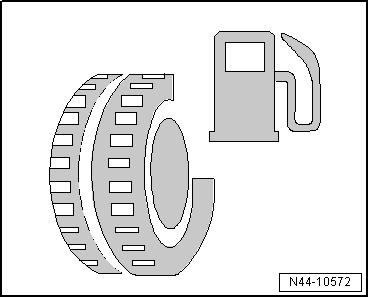
|
| Separated into fuel efficiency classes A to G |
 Note Note
| The fuel efficiency classes are listed in EU Regulation (EG)
1222/2009. Tires categories are established by this regulation. |
| The rolling resistance is ascertained by prescribed tests
performed by the tire manufacturer. |
| The lower the rolling resistance, the lower the fuel
consumption. |
| A - |
Lowest rolling resistance coefficient = lowest fuel
consumption |
| B - |
+ 0.10 liters / 100 km |
| C - |
+ 0.12 liters / 100 km |
| E - |
+ 0.14 liters / 100 km |
| F - |
+ 0.15 liters / 100 km |
| G - |
+ 0.15 liters / 100 km |
|
|
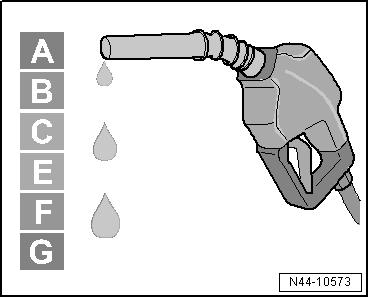
|
| For the wet grip, the wet grip parameter G must be
determined. The wet grip parameter G is defined by testing the
distance required by a standardized vehicle to brake from 80
km/h (49.7 mph) down to 20 km/h (12.42 mph) on a wet, even road
surface. The test is performed using predefined standard
reference test tires (SRTT), allowing for the wet grip parameter
G to be determined. Mean fully developed deceleration (mfdd) is
used for the test. |
| The mean fully developed deceleration is determined thusly: |
| S - the braking distance between 80 km/h (49.7 mph) and 20
km/h (12.42 mph) in meters |
| The wet grip parameter G is determined thusly: |
| |
G =
| mfdd of the
tire to be checked |
| mfdd of the standard reference tire |
|
| mfdd - mean fully developed deceleration |
| Sharp decrease in braking distance |
|
|
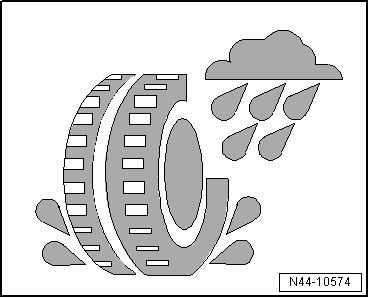
|
| Separated into wet grip classes A to G |
| Classes D and G are not used |
 Note Note
| The wet grip classes are listed in EU Regulation (EG)
1222/2009. Tires categories are established by this regulation. |
| The lower the wet grip parameter, the shorter the braking
distance. |
| A - |
lowest wet grip parameter = shortest braking distance |
| B - |
3 to 6 m longer braking distance compared to category A |
| C - |
3 to 6 m longer braking distance compared to category B |
| E - |
3 to 6 m longer braking distance compared to category C |
| F - |
3 to 6 m longer braking distance compared to category E |
| 1 - |
When emergency braking at 80 km/h (49.7 mph), the difference
between using class A and class F tires can be more than 18 m. |
|
|
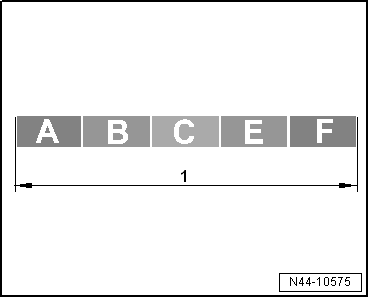
|
| Take measurements from outside of the vehicle only |
| Divided into three classes |
|
|
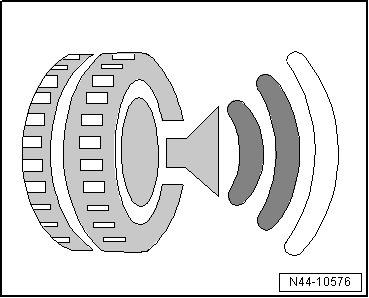
|
| Three black waves signify the worst performance. The tire
produces external rolling noise, which falls below the current
EU Directive 2001/43/EG limit. The limit surpasses the future
limit set by EU Regulation (EG) 661/2009, which will go into
effect in 2016. |
| Two black waves: the tire noise level does not exceed the
future limit set by EU Regulation (EG) 661/2009, which will go
into effect in 2016. |
| One black wave: the tire noise level does not exceed the
future limit set by EU Regulation (EG) 661/2009, which will go
into effect in 2016, by at least three decibels. |
 Note Note
| Reducing the noise measured value from two black waves down
to one corresponds to 3 dB, which halves the noise level. |
| Please note that extreme tire rolling noise does not always
correspond to the noise in the vehicle interior. |
|
|
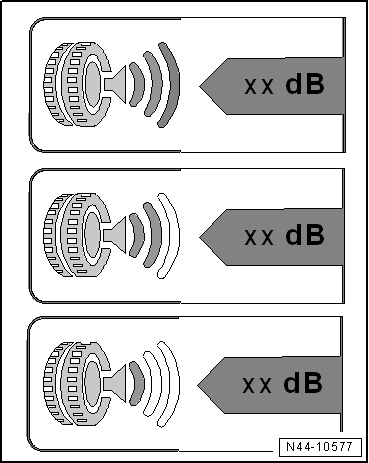
|
To reduce fuel usage
To improve road safety
To reduce traffic noise
The EU Tire Label Provi ...
Other materials:
Using a child seat on the rear seats
First read and observe the introductory information
and safety warnings
When fitting a child seat to a rear seat, the position of the front seat must
be adjusted to ensure that the child has sufficient space. Adjust the front seat
according to the size of the child seat and child. Ensure that ...
Infrared Dryer -VAS6874
Definition:
Infrared Dryer -VAS6874-
Product Description:
The infrared dryer is used to dry paste, filler, base paint,
top coats and clear coats on vertical surfaces using two clock
timers fo ...
Removing the ball coupling
First read and observe the introductory information
and safety warnings
Unhitch the trailer .
Remove the cover from the lock on the handwheel.
Insert the key ⑧ into the lock and turn it clockwise.
Hold the ball coupling tightly in your left hand .
Use your right ha ...
© 2016-2026 Copyright www.vwpolo.net

 Note
Note Note
Note Note
Note EU Tire Label, Goals
EU Tire Label, Goals






